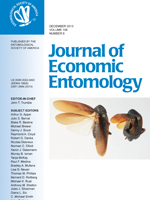The Asian corn borer, Ostrinia fumacalis (Guenée), is a major pest of maize in China. Transgenic Bt maize could provide an effective way to control this pest. However, the potential of resistance evolution has been documented in the laboratory—a Cry1Ab-resistant strain of Asian corn borer (Asian corn borer-AbR) could survive well on two Bt maize events, that is, MON810 and Bt11. Pyramided transgenic crops with multiple dissimilar Bt insecticidal proteins offer a superior route for pests control compared with that with one Bt single gene. In this study, two novel transgenic Bt maize events (N30 and V3), which contained a fused gene cry1Ab/cry2Aj and cry1Ab/vip3DA, respectively, were evaluated for their efficacy on protection against Cry1Ab-susceptible Asian corn borer (Asian corn borer-BtS) as well as their potential for dealing with the Asian corn borer-AbR. In laboratory bioassay, no neonate larvae of Asian corn borer-BtS fed on the whorl leaves, tassels, husks, silks, and kernels of N30 and V3 could survive at 96 h after infestation. In contrast, only 2.0–8.7% larvae died as they fed on non-Bt maize tissues. As Asian corn borer-AbR neonate larvae fed on N30 and V3 silks and kernels, 95.0% even more larvae were killed at 96 h after infestation, and all died at 168 h after infestation, while 10.0–11.67% larvae survived on non-Bt control. In the field test under artificial infestation at middle whorl leaf and silking stages of maize, there were no significant leaf, silk, and stalk damage on Bt maize plants by comparison with severe leaf feeding, stalk born, and ear damage in control. In addition, the expression profiles of a fused protein of Cry1Ab/Cry2Aj or Cry1Ab/Vip3DA in different tissues of N30 and V3 were also confirmed. In conclusion, it is clear that both Bt maize events (N30 and V3) show great potential for protecting maize from attack by Asian corn borer that has resistance to Cry1Ab protein.
How to translate text using browser tools
1 December 2013
Efficacy Evaluation of Two Transgenic Maize Events Expressing Fused Proteins to Cry1Ab-Susceptible and -Resistant Ostrinia Fumacalis (Lepidoptera: Crambidae)
X. Chang,
G. G. Liu,
K. L. He,
Z. C. Shen,
Y. F. Peng,
G. Y. Ye
ACCESS THE FULL ARTICLE
It is not available for individual sale.
This article is only available to subscribers.
It is not available for individual sale.
It is not available for individual sale.
Cry1Ab/Cry2Aj protein
Cry1Ab/Vip3DA protein
insect resistance evaluation
Ostrinia fumacalis
transgenic maize





